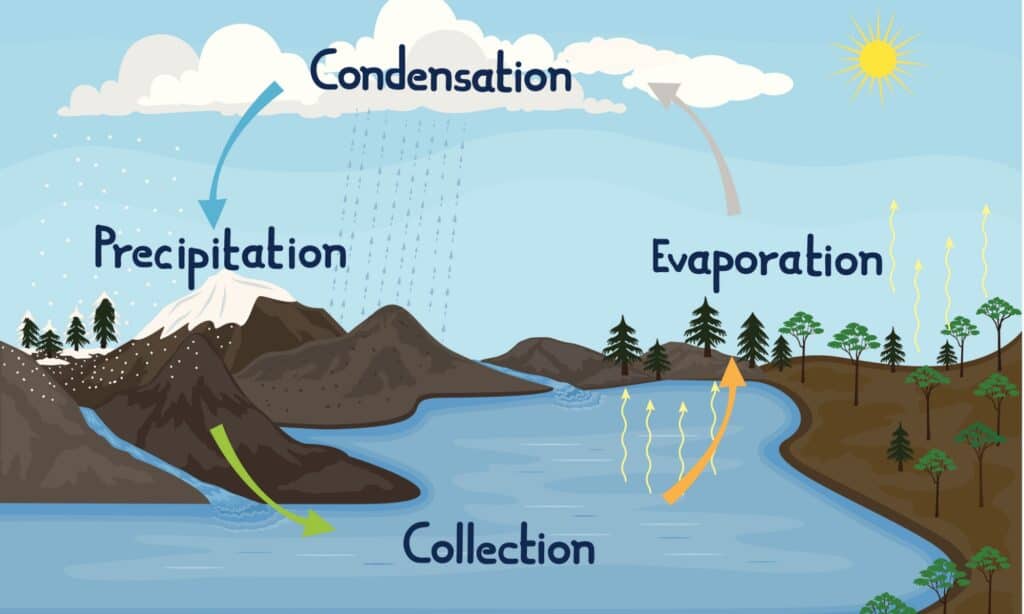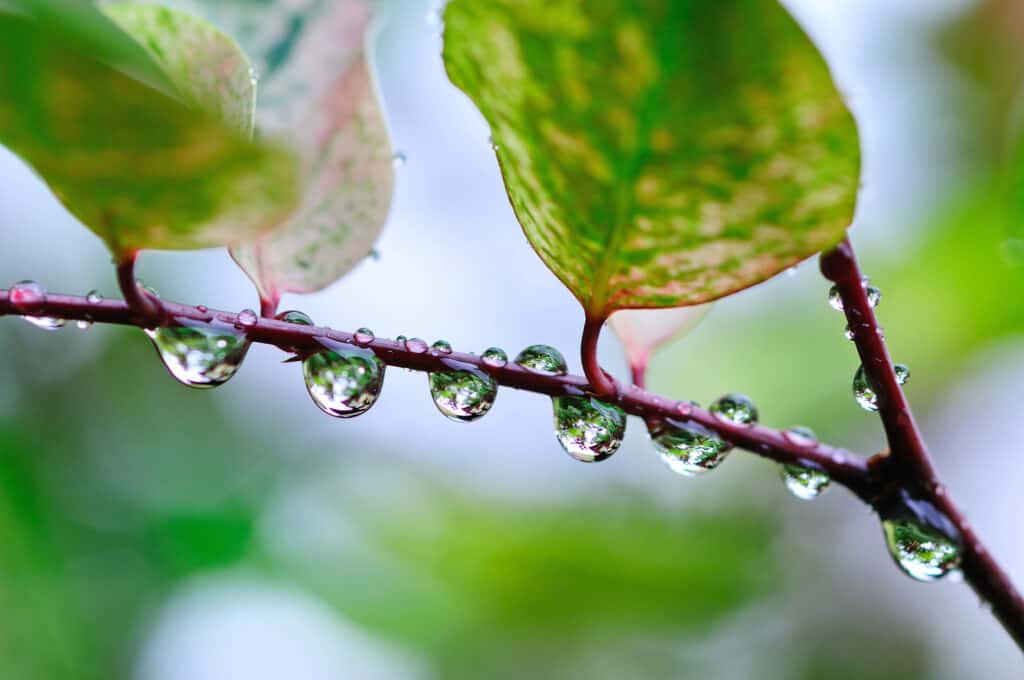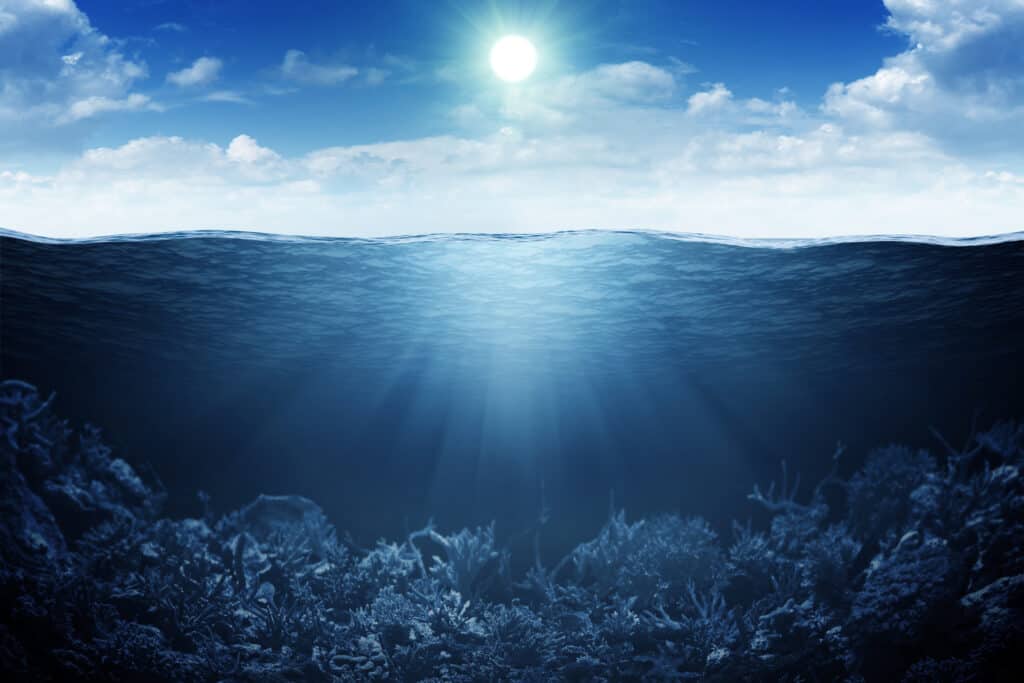Have you ever looked out the window at the rain and wondered just where it came from? If so, you’re not alone. Learning more about precipitation and water on Earth means learning more about what the water cycle is.
If you’re not familiar with the water cycle, no worries! Below, we’ll walk you through both a simplified and complex look at how water moves. Ready to learn more? Let’s dive in!
An Overview of the Water Cycle
It can be difficult to put the water cycle into one word. However, one of the best definitions for it is simply “the way that water moves continuously around the world.”
All of the water that is around today has been here for millions of years. That’s right! There’s a chance you’re drinking the same water a mighty plesiosaur swam in!
During the water cycle, water can and will change between the different states of matter. There are three different states of matter: solid, liquid, and gas. Matter, like water, can change between these different states of matter by changing temperatures. Below freezing, water is a solid (ice); water becomes a gas (steam or water vapor) at its boiling temperature. In between those two temperatures, water is in a liquid state.
Now that you’ve learned a bit more about the overall answer to “What is the water cycle,” it’s time to dive into the specifics.

During the water cycle, water can and will change between the different states of matter.
©mervin07/Shutterstock.com
Water Cycle Simplified
Although the water cycle can be a highly complex system with several moving parts, you can actually condense it down into three overall steps: evaporation, condensation, and precipitation.
Let’s start by thinking about your average lake. If you have one in your hometown, you can think about it. Lakes are one type of water source, and they’re filled with fresh water in a liquid state. When this water is warmed by the sun, it begins to evaporate. This is the process of water switching from liquid to gas.
Once in the gaseous form of water vapor, the water from the lake condenses into clouds. Here, it’s still mostly gaseous, but some solids begin to form again. This leads to precipitation. This is snow or rain.
The Complete Water Cycle
While a single glance at the water cycle can seem pretty simple, there are actually a lot more than three steps.
First, evaporation doesn’t just occur from sources of water. There is also a form of evaporation known as transpiration. This is also known as plant uptake, as it is water that comes from plants and collects in the atmosphere.
There is also water that cannot be evaporated, at least not right away. When it rains, the water that is not absorbed by plants or runs off into a body of water like a lake seeps deep underground. Here, it collects in a water source known as groundwater. This is what wells connect to. Sometimes, this water is reabsorbed by plants or used for human consumption. It can also resurface from areas like springs. From there, it is able to be evaporated and returned to the atmosphere.
Snow and ice do not evaporate immediately, especially in high-elevation areas. Instead, the snow and ice will melt and run off the mountain to pour into rivers and streams. Some of it is evaporated along the way, while the rest makes it to the ocean.
Overall, the water on the planet is constantly moving and being recycled and reused, even if you cannot always see it.

The water on the planet is constantly moving and being recycled and reused.
©iStock.com/Damon_Moss
Why Is the Water Cycle Important?
The water cycle is important because it is how everything is able to live! From plants to animals to people, we all rely on water for survival. If the water cycle weren’t to exist, we would eventually run out of water.
However, thanks to the water cycle, all water is recycled and reused. This allows for nature to continue to thrive.

Plants, animals, and people all rely on water for survival.
©iStock.com/Korovin
How to Protect Earth’s Water
All of the water that has ever existed on Earth still exists today. This also means that all the water that exists today will be the only water in the distant future. As a result, we must learn how to conserve and protect our water.
Here are some steps you can take to help keep Earth’s water clean and safe for generations of humans, animals, and plants to come:
- Contribute to cleanup programs around water sources such as beaches and wetlands
- Learn more about the different types of water sources
- Don’t flush anything but human waste and approved products in your toilet
- Don’t overuse unnatural fertilizers
- Learn more about supporting plants native to your area.
The photo featured at the top of this post is © Artem Pachkovskyi/Shutterstock.com
Sources
- Research Gate, Available here: https://www.researchgate.net/profile/T-Harrold/publication/260072736_The_global_water_cycle/links/5f1798f4299bf1720d58d0eb/The-global-water-cycle.pdf
- Science Direct, Available here: https://www.sciencedirect.com/science/article/abs/pii/S0168192314000203
Thank you for reading! Have some feedback for us? Contact the AZ Animals editorial team.






